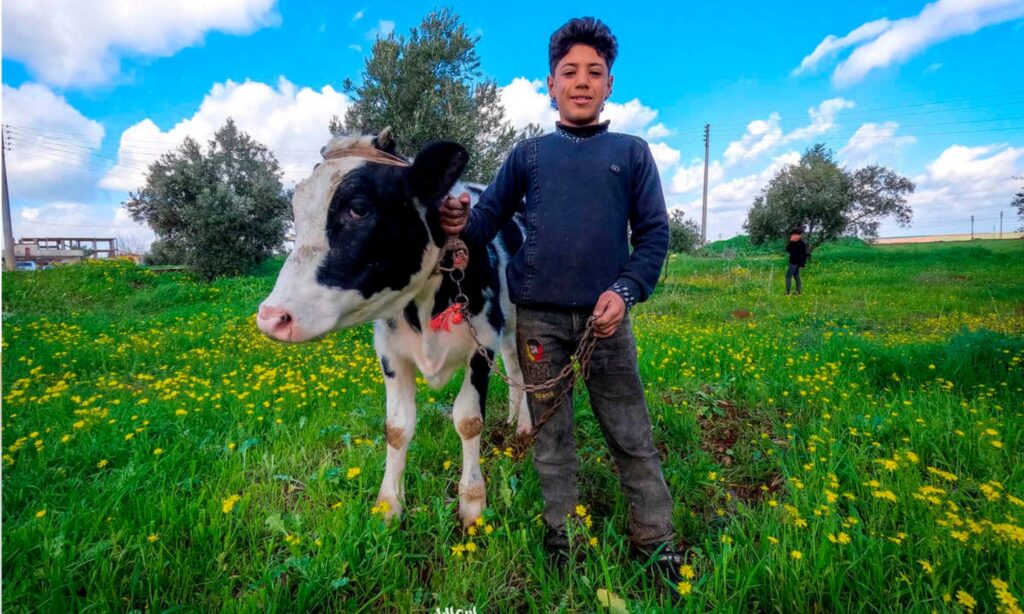Daraa – Halim Muhammad
At the beginning of March, the prices of milk and dairy products in the Daraa governorate in southern Syria decreased by approximately 20% for milk and 40% for cheese varieties.
This decrease is due to the abundance of pastures that flourished with the copious rainfalls since the start of the winter season, reflecting an increase in milk quantities.
The price drop did not incentivize residents to stock up for other seasons due to a decrease in financial capability, according to a monitoring by Enab Baladi.
Varying degrees of reduction
The price of cow’s milk per kilo has reached 4,500 Syrian pounds, down from 5,500 pounds in February, and the price of sheep’s milk has dropped from 7,500 pounds to 6,000 pounds per kilogram.
The local market has also seen a decrease in the prices of local cheese, with the price of a kilo of cow cheese reaching 25,000 Syrian pounds after having been 45,000 pounds at the start of the year, while the price of a kilo of sheep cheese dropped from 30,000 to 18,000 pounds.
The price of a kilo of strained yogurt (Al-Mudhbar) decreased from 65,000 to 55,000 pounds, and a kilo of local ghee went from 125,000 to 100,000 Syrian pounds.
Every US dollar is equivalent to 14,000 Syrian pounds, according to the S-P Today website, which specializes in currency exchange rates.
Ali (45 years old), who owns a dairy shop in Tal Shihab in the western countryside of Daraa, attributed the variation in cheese prices to the fact that every two kilograms of sheep’s milk produce one kilo of cheese, whereas producing one kilo of cow cheese requires four kilograms of milk.
Weak demand
Ahmed al-Mufalani (40 years old), who makes dairy derivatives at his home in the town of Nahteh in the eastern countryside of Daraa, told Enab Baladi that the drop in dairy products’ prices is linked to milk prices.
It is well-known that there is an abundance of milk production in this period of the year from February until the end of August, al-Mufalani added.
Al-Mufalani mentioned that the fat content in milk is high during March and April; hence, cheese and dairy making proliferates. Usually, some buy it for stockpiling, but he described this season’s demand as weak, limited only to meeting daily needs.
Al-Mufalani also mentioned that despite the drop in milk prices, the profits from producing derivatives are meager, especially with the increased costs of production, which include the prices of gas necessary for boiling milk. The price of a household unsubsidized gas cylinder has reached 375,000 Syrian pounds in the local market of Daraa governorate.
Breeders are losing
Along with the drop in milk prices, feed prices have continued to rise, causing losses for livestock breeders. Sheep and cows need fodder in addition to herbs, and the milk production does not cover the cost of feed.
The price of a kilo of feed containing primary elements such as soybean meal, maize, barley, and wheat reached 5,000 Syrian pounds.
Mohammed Dhiab, who owns three cows in the western countryside of Daraa, told Enab Baladi that the decrease in milk price and the increase in fodder cost cause losses for the breeders. He added that the milk produced by his cows is about 40 kilos daily, currently relying mainly on grazing.
He noted that the amount of milk produced by his cows is low because it could reach 60 kilos if he relied on fodder in addition to pastures for feeding.
A veterinarian residing in Daraa (who asked not to be named for security reasons) told Enab Baladi that relying solely on pasture feeding without using fodder reduces milk production and density. The milk of cows fed on fodder is creamier than pasture milk.
The veterinarian warned of the dangers of feeding livestock wet grass with dew in the morning, which could lead to bloating, pointing out the importance of feeding them hay and fodder before heading to the pastures.
The veterinarian added that each kilo of feed produces two kilograms of milk if the fodder contains the necessary materials that provide the cow with protein and energy. The most important of these substances are soybean meal, fava beans, maize, and barley.
The number of cows in Daraa is estimated at 43,264 heads, sheep at 779,139 heads, in addition to 119,054 heads of goats.











